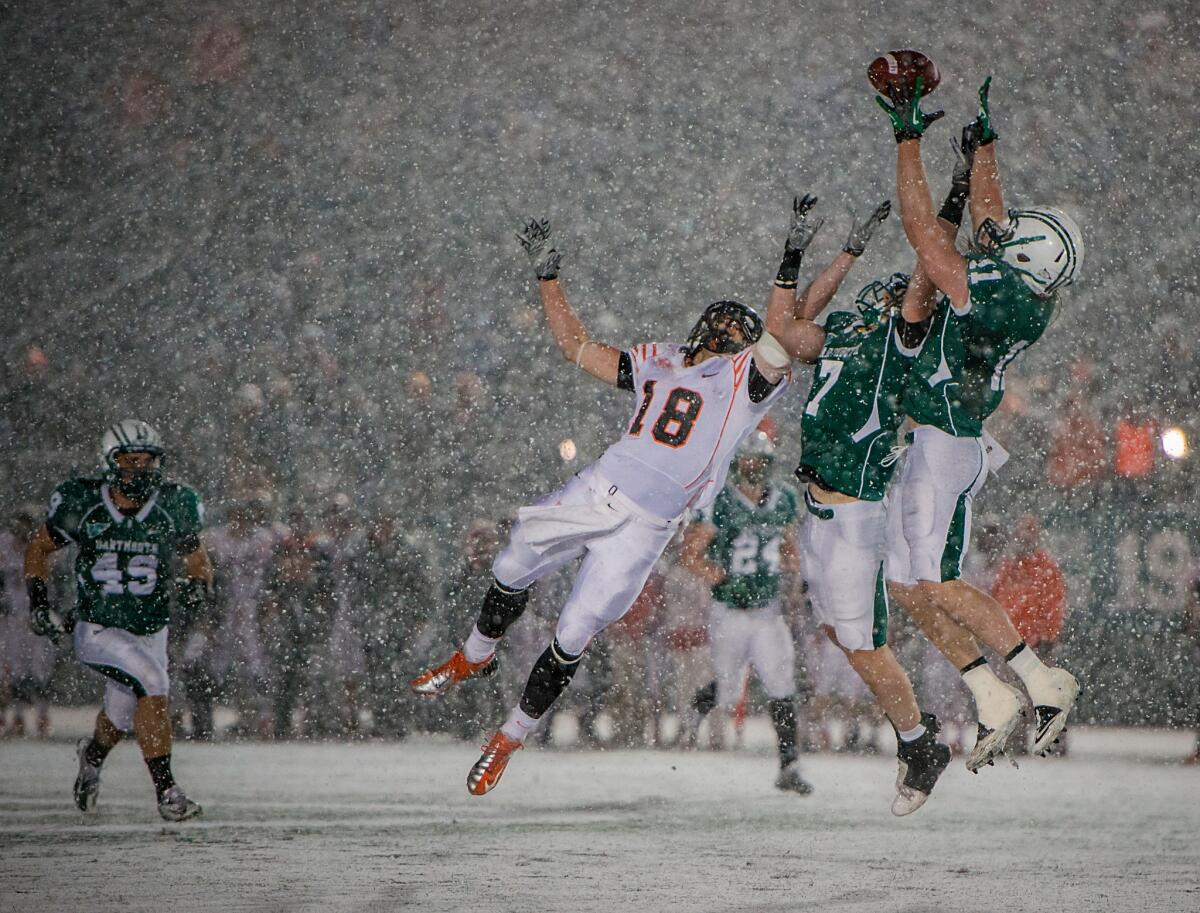Head injuries in one football season cause measurable brain damage

- Share via
For college athletes who get through their sport’s season concussion-free, new research suggests it may be too early to breathe a sigh of relief.
Following a season of grueling practices and hard-fought games, football and ice hockey players who had no outward sign of head trauma showed worrisome changes in brain structure and cognitive performance that weren’t shared by athletes who competed in varsity sports such as track, crew and cross-country skiing, according to a report published Wednesday in the journal Neurology.
The findings add to a growing body of evidence suggesting that a season-long succession of small hits — none hard enough to cause evident disorientation or draw medical attention — may prompt changes in the brain that cause problems with memory, mood or mental performance years down the road.
Or, they may heal during the off-season. Scientists are still trying to figure out how readily the brain recovers from injury, or whether there are thresholds beyond which damage can be cumulative or irreversible.
The new results don’t resolve the matter, but they do suggest that repetitive blows to the head are not without consequence, even when an athlete is able to get up and keep playing, said study leader Thomas McAllister, a psychiatrist at Indiana University.
“The management and detection of concussion is obviously important,” McAllister said. “But may not be sufficient.”
The study centered on 159 students at Dartmouth College in Hanover, N.H. — where McAllister worked until last year — who played on varsity teams between 2007 and 2011. Except for football, all of the sports were played by both men and women.
The 80 athletes who played contact sports wore accelerometers in their helmets that measured the number and force of blows to the head during all practices and games. In addition, all of the study participants got MRI brain scans and took wide-ranging mental performance tests before and after their seasons.
Looking only at athletes who were not diagnosed with a concussion during the season they were tracked, the researchers drew important connections between blows to the head and changes in brain structure as well as the students’ cognitive performance weeks after their sport ended.
MRI scans that measured the density and integrity of the brain’s white matter — the bundles of fatty tissue that speed electrical signals among neurons — showed that after a single season, football and hockey players experienced changes that were greater than anything seen in the brains of the athletes who played noncontact sports. In addition, players who had the biggest changes in white matter had the worst performance on postseason tests of verbal learning and memory.
McAllister said the good news was that despite years of playing their sports — and presumably suffering repeated blows to the head — the white matter of contact-sport athletes at the start of their seasons was largely indistinguishable from that of athletes in noncontact sports. That suggests the brains of college athletes may largely bounce back from a season’s wear and tear.
But it will take far more research to discern whether there are certain athletes who don’t heal as well, or for whom small changes in the brain structure can have outsized, and possibly delayed, effects.
“We know some of them heal. But some of them don’t,” said Eric Nauman, a Purdue University biomechanical engineer who has spent five years tracking the effects of small and large hits meted out on high school gridirons.
The resolution with which MRIs can detect white matter changes is limited, so the fact that differences were seen in the Dartmouth athletes is remarkable, Nauman said.
“If you’re seeing structural changes at the level the MRI can pick up, that is very worrisome,” said Nauman, who was not involved in the study. “We’re desperately trying to figure out what the long-term implications are.”
McAllister said his initial goal was to find a threshold for hits that were safe and hits that caused concussions. But years of study have made him suspect that if such a threshold exists, it may tell only part of the story.
Well before they result in concussion, blows to the head change the brain’s structure and the way it works, at least temporarily, he said. And there’s growing evidence that a succession of those smaller hits puts players at higher risk for the one that finally trips a concussion diagnosis, McAllister said.
“You quickly see that the emphasis on the hit is misplaced,” he said.
ALSO:
Heads-up for dangerous football hits, trainers warn
Could a blood test detect concussion with lasting disability?
Study: No helmet brand can save football players from concussion risk







